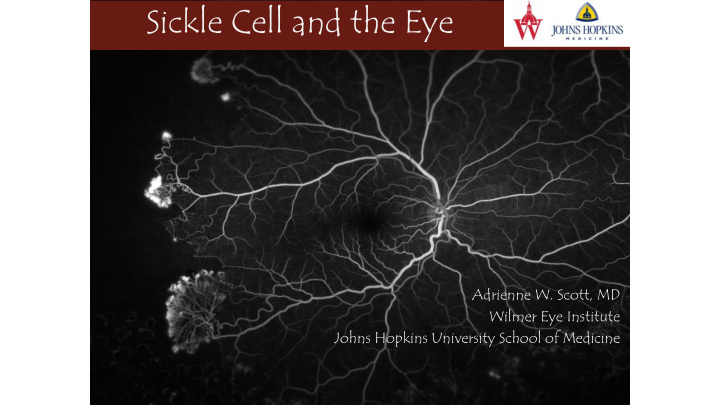



Sickle Cell and the Eye Adrienne W. Scott, MD Wilmer Eye Institute Johns Hopkins University School of Medicine
Disclosures • Allergan, Inc. (Consultant) • No financial interest in this subject matter
Sickle Cell and the Eye- Take Home Points • Sickle cell disease can affect any part of the eye • Retinopathy risk variable, depends on genotype • Male sex, older age, visual symptoms and floaters associated with retinopathy • Dilated fundus exam required at least annually beginning at age 10, younger if possible • Treatment can prevent vision loss
Orbital Involvement • Retro-orbital and Orbital Involvement – Orbital bone infarction – Orbital compression syndrome • Fever, lid edema, facial pain Schundeln et.al, Journal of Pediatrics, 2014.
Anterior Segment
Sickle Cell Retinopathy • Goldberg staging (AJO 1971) – Stage I: peripheral arteriolar occlusions – Stage II: peripheral arteriolar-venular anastomoses – Stage III: neovascular and fibrous proliferation – Stage IV: vitreous hemorrhage – Stage V: retinal detachment Top photo by Andrew R. Marks, M.D.
Non-Proliferative Sickle Cell Retinopathy
Stage 1: Peripheral arteriolar occlusions
Stage 2: Arteriolar-venular anastomoses
Stage 3: Neovascularization
Stage IV: vitreous hemorrhage
Stage IV: vitreous hemorrhage Seafans visible despite vitreous heme
Stage V: vitreous hemorrhage Combined TRD/RRD
Image Courtesy of the American Society of Retina Specialists (ASRS) image Bank
Sickle Cell Maculopathy • Numerous macular abnormalities possible • Hairpin venular loops • Microaneurysmal dots • Foveal avascular zone irregularities • Macular ischemia does not develop neovascularization • Many patients with abnormalities but no visual consequence
Multimodal Imaging in SCR
Multimodal Imaging in SCR
Treatments for Sickle Cell Retinopathy • Mostly observation, unless…. Stage 3 Stage 4 Stage 5
Treatments • Laser photocoagulation • Intravitreal injection of anti-vascular endothelial growth factor agents (anti-VEGF)
Post-treatment Pre-treatment Post-treatment Pre-treatment
Practical Questions • What about glasses? – Refractive error separate • Is all this retinal imaging testing necessary? – Not sure, a thorough dilated exam will pick up serious retinal pathology • So do all with SCD have retinopathy? – Probably, and will increase as they age • Is vision loss in SCD certain? – Probably not, risk is low, but subtle vision loss may be underdiagnosed • When are sickle cell retinopathy screening exams necessary? – At least annually, age 5 and older, NHLBI consensus suggests age 10 – Floaters, or vision loss, HbSC/Beta thal
Acknowledgements • Ian Han, M.D. • Sally Ong, M.D. • Marguerite Linz, B.A. • T.Y. Alvin Liu, M.D. • Morton F. Goldberg, M.D. • Hematology Department at JHU-SOM
Recommend
More recommend